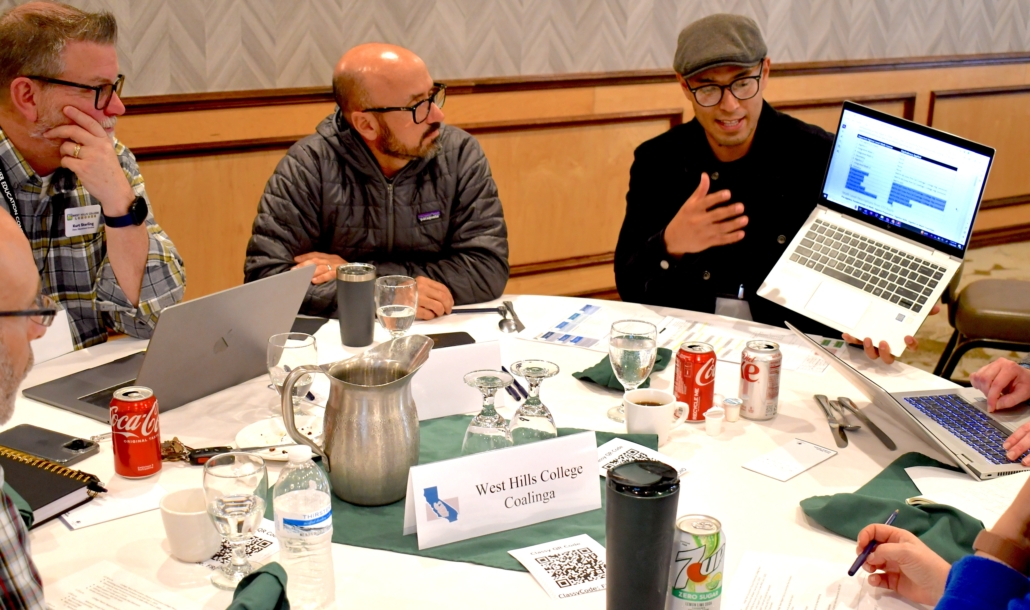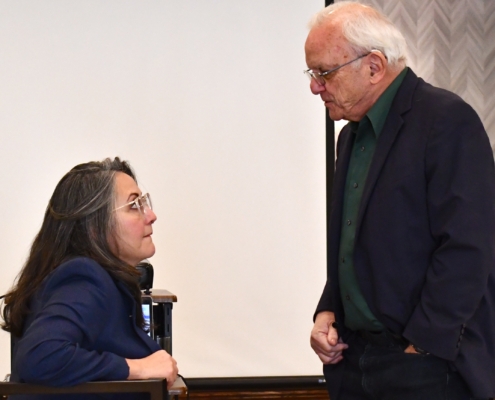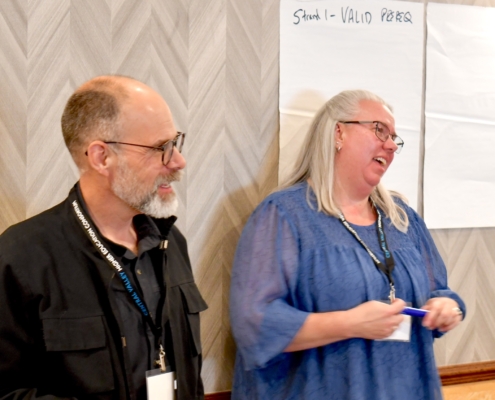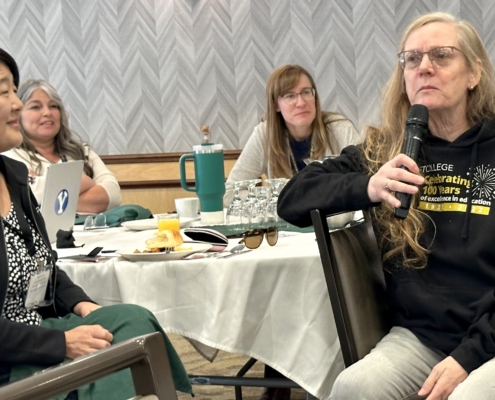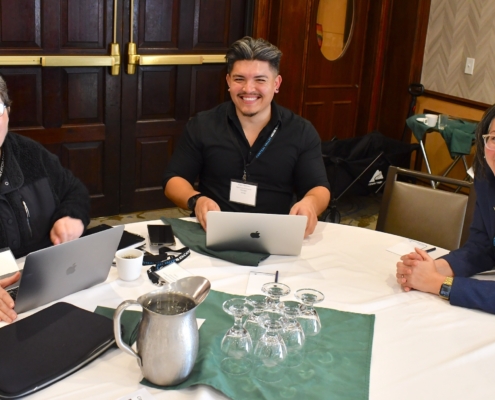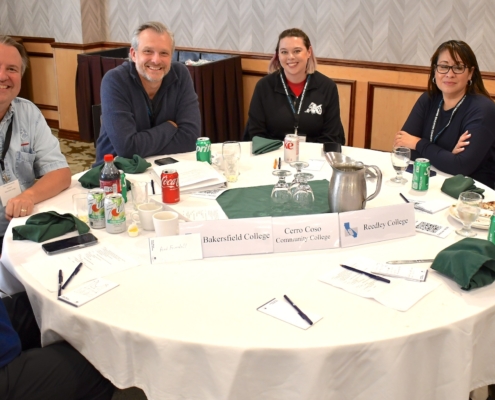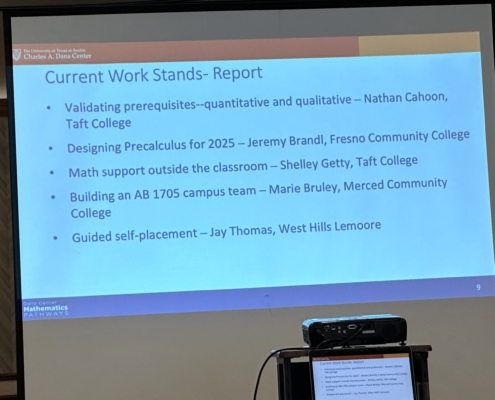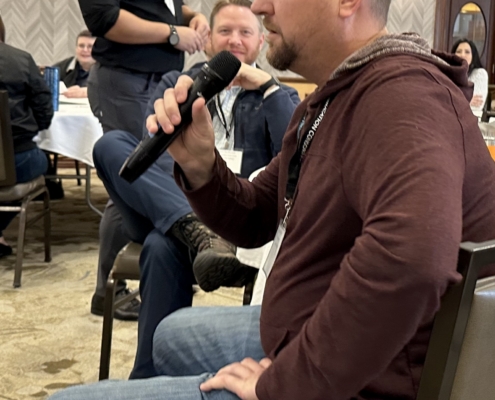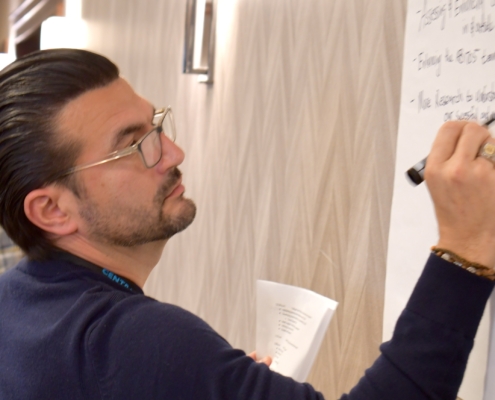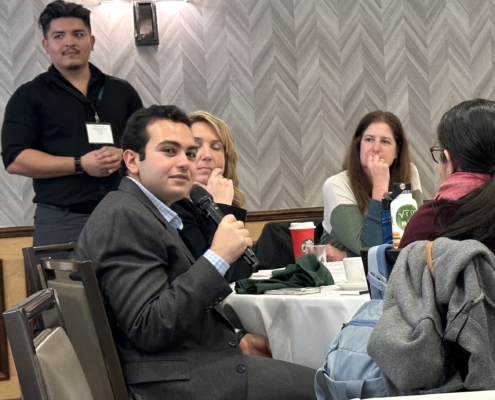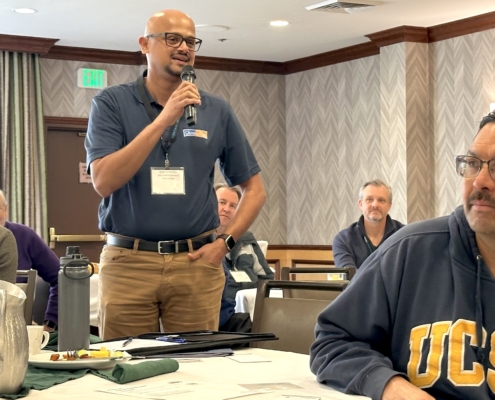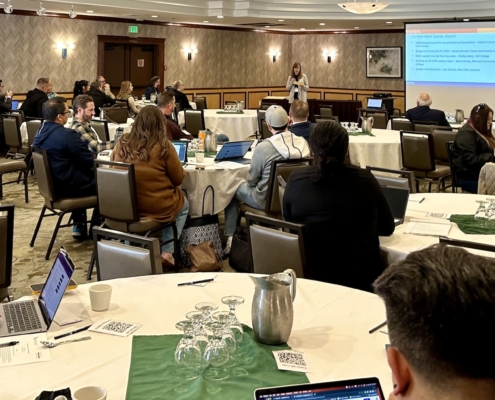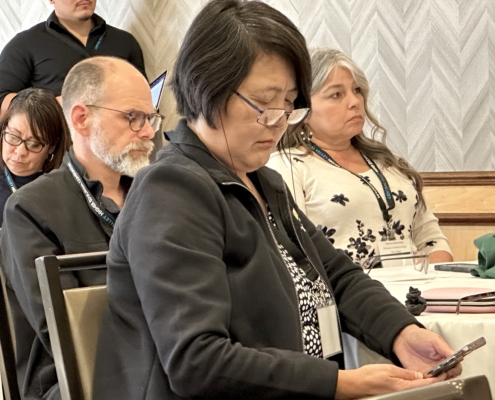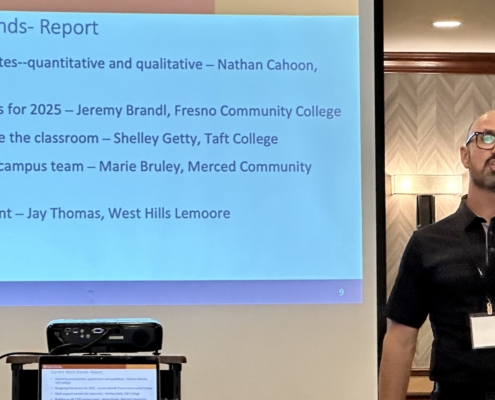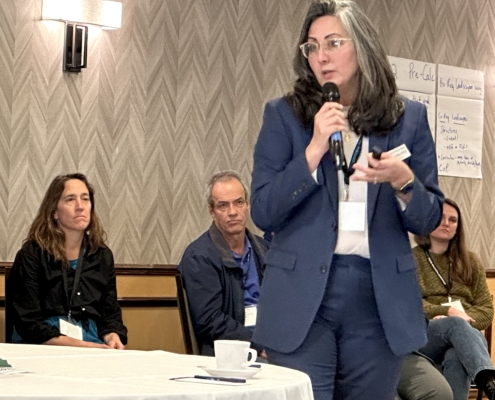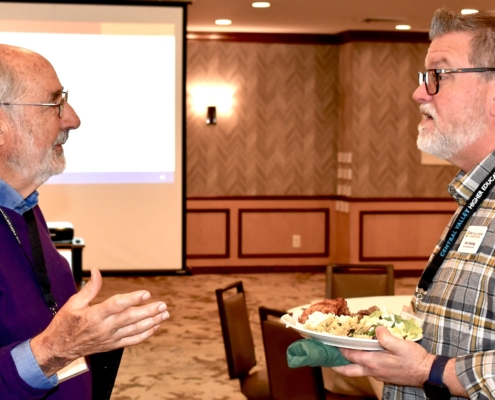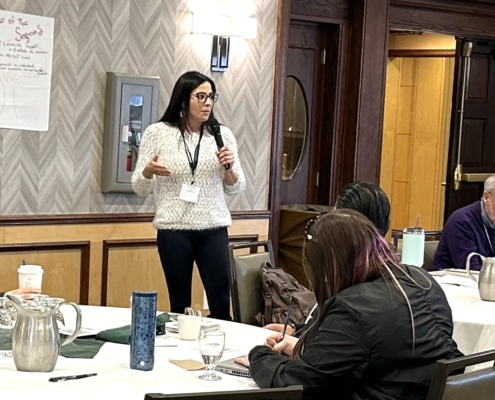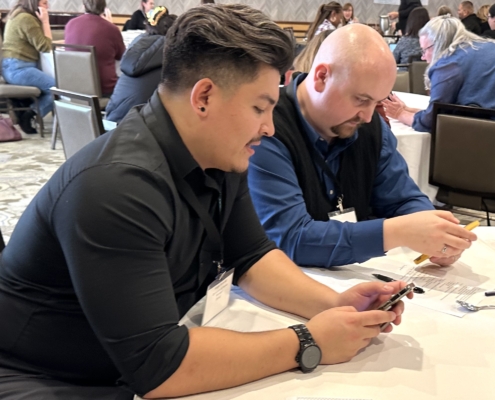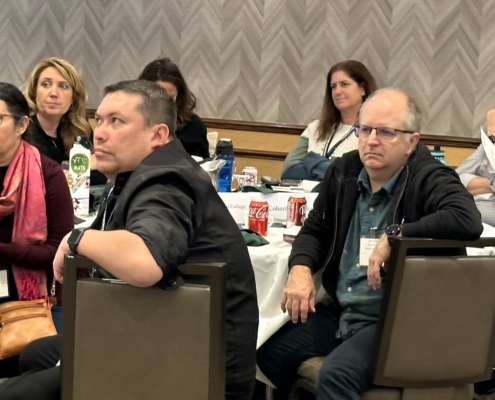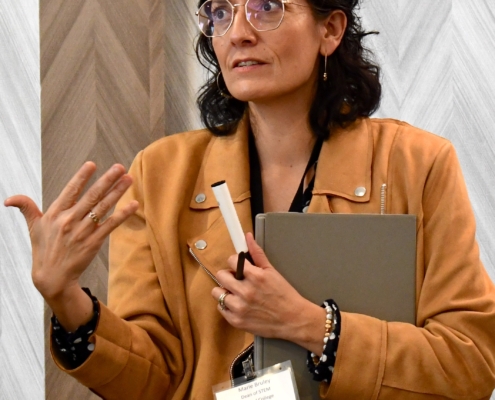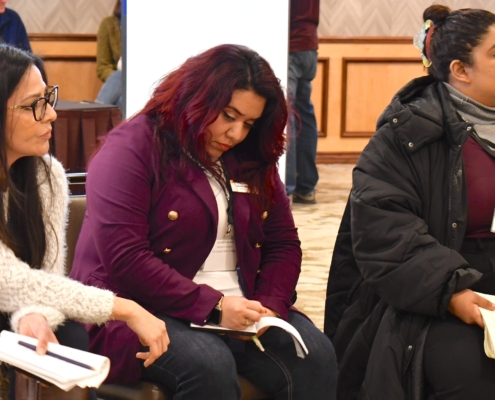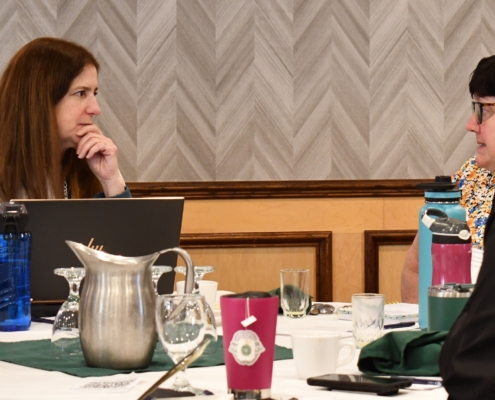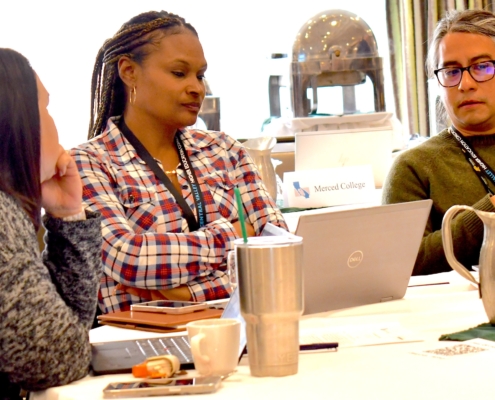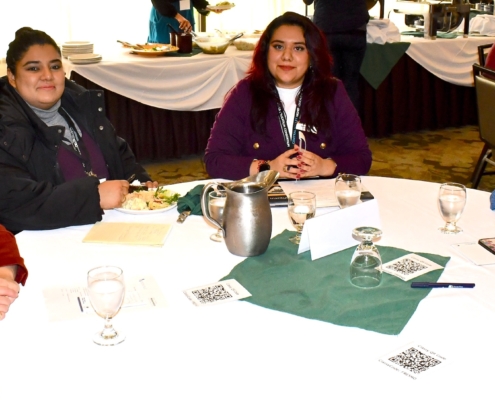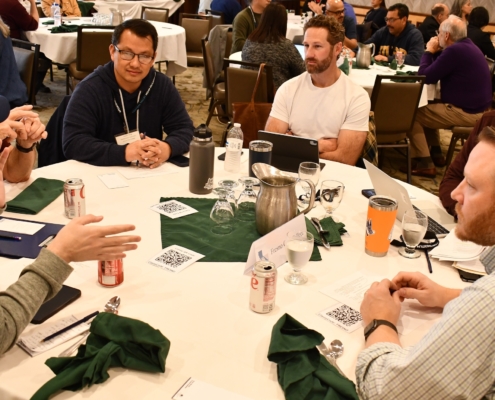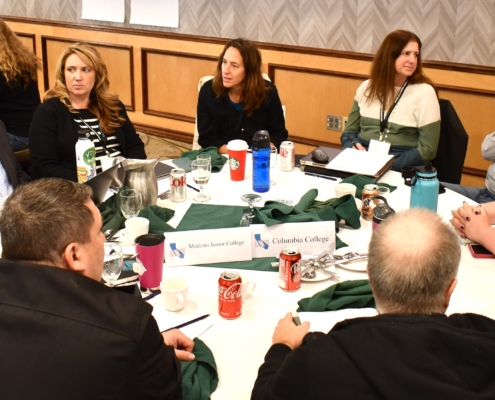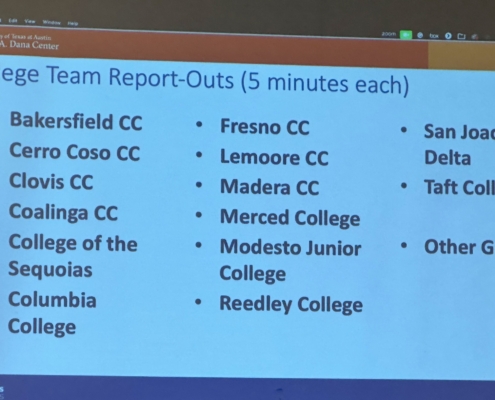In the “What the CV-HEC is Happening” Blog for our summer 2024 special edition, Dr. John Spevak presents an observation about the value of a higher education. Dr. Spevak, […]
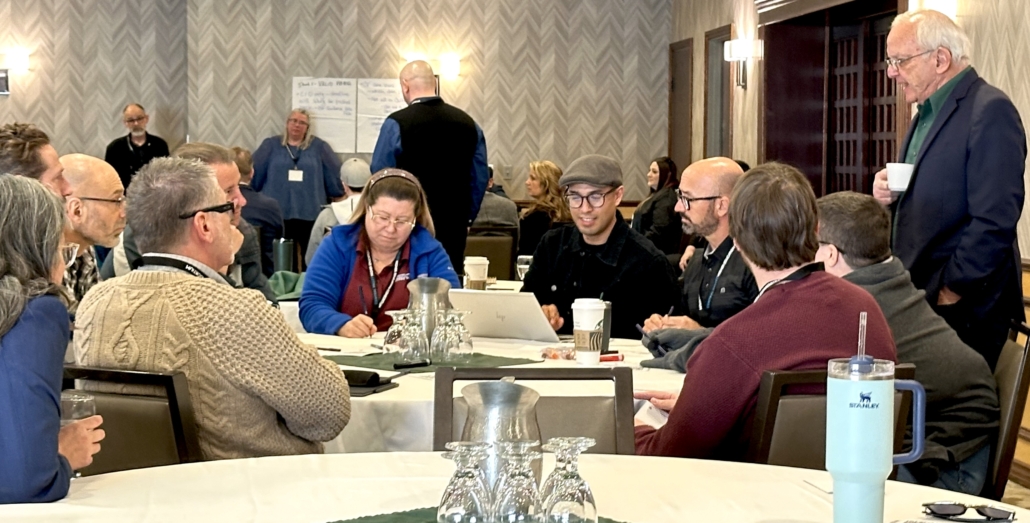 Dr. John Spevak (at right), vice president-emeritus of Merced College and currently a regional coordinator for CVHEC, was an English teacher early in his career and now coordinates the English and Math Task Forces for the consortium working directly with community college teachers in the valley’s nine-county region. Here he facilitates the Math Task Force convening in Fresno January 26. For Teacher Appreciation Week, CVHEC reposts this column Dr. Spevak wrote for the Westside Express recently. This occasion is a special time to honor the men and women who lend their passion and skills to educating our children. It’s a chance for parents, caregivers, and community members to celebrate the hard work and dedication of teachers and school staff throughout the year.
Dr. John Spevak (at right), vice president-emeritus of Merced College and currently a regional coordinator for CVHEC, was an English teacher early in his career and now coordinates the English and Math Task Forces for the consortium working directly with community college teachers in the valley’s nine-county region. Here he facilitates the Math Task Force convening in Fresno January 26. For Teacher Appreciation Week, CVHEC reposts this column Dr. Spevak wrote for the Westside Express recently. This occasion is a special time to honor the men and women who lend their passion and skills to educating our children. It’s a chance for parents, caregivers, and community members to celebrate the hard work and dedication of teachers and school staff throughout the year.
Teaching English In A Community College:
Today Versus Yesterday
BY DR. JOHN SPEVAK
CVHEC Regional Coordinator
Vice President-Emeritus – Merced College
The other day I had a conversation with college professors who teach English to community college students (as I taught English at the Los Baños college campus many years ago).
I came away from that conversation thanking my lucky stars I taught in the 1970s and 80s — and not today.
When I taught my first English class at the Los Baños Campus of Merced College in 1971, life was good, and so was teaching. I enjoyed sharing my love of reading and writing with the students gathered in my classroom.
I appreciated the many times when the students, young and old, expressed their increased enjoyment of reading and writing as a result of being in my class. There were many lively, interpersonal interactions.
When I gave writing assignments, I knew my students were responding with their own thoughts and ideas, which often were the result of questions they asked in class. I appreciated the growth I saw as students became more proficient writers, as well as more thoughtful readers.
And I enjoyed it when students came into my office and engaged in thoughtful conversations, with questions that enabled them to explore ideas in more depth.
Today, however, for all professors in community colleges but especially those who teach English, teaching has become much harder and less interpersonal.
Today’s community college English professors have to navigate and endure six challenges I never had to face: “bot students,” having to teach online, the lingering consequences of COVID, two new state regulations and (most recently) artificial intelligence.
I don’t know how they do it. But listening to them, I realize they persist while keeping their love for English and their passion for helping students succeed.
“Bot students” was a term that was new to me. My colleagues explained these are fraudulent or fake students, names and student ID numbers of nonexistent people that show up on class lists. Bot students are the work of sophisticated cyber-scammers trying to illegally collect financial aid.
One English professor told me he noticed 30 names on his first class roll sheet, only to find that just five of them were real.
College technology administrators are doing everything they can to distinguish real students from bot or fake students, but scammers keep finding new ways for bot students to appear on class roles, especially for online classes.
This brings up another current challenge for community college professors—teaching online. Currently about 50 percent of community college students prefer taking courses online instead of in person. For a professor to keep her or his job, this almost always results in being required to teach one or more classes online.
Teaching online, something I never had to do as an English instructor, is much different from teaching in person, especially after two years of COVID, during which the only classes were online.
Good online teachers really have to work to get interactions between themselves and their students. And they have to make sure the students’ work is truly their own.
COVID also created another challenge. During the pandemic, most high schools were reluctant to give Fs to students because many students had insurmountable challenges to online access. In many cases students passed courses just by virtually showing up.
After COVID, a lingering challenge for community college professors is the “COVID” approach many students have about passing the course. They ask their professors, “You mean I have to do the work?”
For California community college English teachers there is still another challenge. A few years ago, the state legislature passed regulations which essentially eliminated remedial English classes. Overall, it was a good idea, because too many students gave up when they had to keep taking remedial courses.
This created a new challenge for English professors. How do they help students who have had limited success in writing become proficient writers in one semester? Good college English teachers have found ways, but it requires much more time and energy than I spent teaching to make this happen.
Meanwhile, recent state legislation also makes it easier for community colleges to offer college classes to high school students on their high school campuses. This was another good idea, enabling more and more students to get a head start on college.
At schools where there are few if any high school teachers with master’s degrees in English, many community college English professors needed to travel to the high schools to teach those college courses.
Finally, here comes artificial intelligence (AI), which makes it much easier for real community college students to cheat by submitting essays generated by a computer and not by their own minds.
Today’s professors, especially in English courses, have to find ways to determine whether a student’s writing is truly his or her own. This is especially challenging when teaching online courses.
Whew, I’m exhausted just listing the challenges today’s community college English professors face that I didn’t 40 years ago.
All of this makes me appreciative and proud of my current English teaching colleagues. The community college English professors I know are determined to meet all these challenges even though it takes much more time and effort to teach English today than “in my day.”
I salute my current English colleagues who continue to do such an important job, making college students better readers and writers and giving them greater opportunities to succeed in college, in careers and in life.
See the original Westside Express version (March 29, 2024 )
CVHEC blogs by Dr. John Spevak :
WHAT THE CV-HEC IS HAPPENING BLOG (September 2023): Teachers
WHAT THE CV-HEC IS HAPPENING BLOG (December 2023): The gift of math
‘Continuing the CVHEC Way
to AB 1705 Success’ – Part II
Math Task Force resumes AB1705 curriculum planning April 19 with
a look at chancellor options, adding high school principals voices to the convo
Many of the best math minds in the Central Valley will resume their Assembly Bill 1705 compliance deliberations April 19 for the latest Central Valley Higher Education Consortium (CVHEC) Math Task Force convening, “Continuing the CVHEC Way to AB 1705 Success – Part II” from 9 a.m. to 3 p.m. at the DoubleTree by Hilton Hotel Fresno Convention Center.
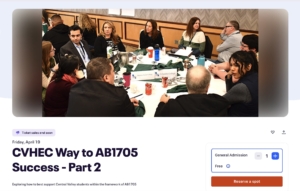 The agenda released last week includes a look at recent guidance from the California Community College Chancellors Office (CCCCO) and introduction of a new Principal’s Strand to the ongoing discussions as they work towards compliance with the final stage of AB1705 by July 1: validation of equitable placement, support and completion practices for STEM programs.
The agenda released last week includes a look at recent guidance from the California Community College Chancellors Office (CCCCO) and introduction of a new Principal’s Strand to the ongoing discussions as they work towards compliance with the final stage of AB1705 by July 1: validation of equitable placement, support and completion practices for STEM programs.
Participants are encouraged to register for the free event by the April 17 deadline said John Spevak, CVHEC regional coordinator who oversees the consortium’s Math Task Force.
About 85 community college math educators, administrators and institutional researchers are expected to re-convene for the day long CVHEC event co-facilitated by the Charles A. Dana Center (University of Texas at Austin), following up two virtual sessions in the fall and two in-person meetings.
This third in-person event on the topic is drawing many new faces with four principals and five other K-12 representatives registered to attend for input regarding what impact AB1705 will have at the high school level and how to work together to align math efforts.
Secondary education leaders registered to attend are:
- Lisa Castillo – Cutler-Orosi Joint Unified School District director
- Matt Gehrett – Dinuba Unified School District director
- Christine Johnson – Dinuba Unified School District math coach
- Celeste Azevedo – Mariposa County High School principal
- Marlena Celaya – Orosi High School principal
- Stasha Tiller – Riverdale High School principal
- Beu Her – Sanger High School deputy principal
- Christina Rubalcava – Stanislaus County Office of Education Math Project coordinator
- Brett Toliver – Stockton Unified School District principal
In addition to college administrators and institutional research participants, registration has also been received from representatives of the California State University Chancellors Office, the California Academic Partnership Program, the Fresno State Department of Curriculum & Instruction and the College Readiness Program, Citrus College (Glendora CA), MESA, STEM counselors and college articulation officers.
“Once again, this is an agenda which is engaging and interactive and enables the best math minds in the Central Valley to determine the best path forward to math success for Central Valley students in light of AB 1705 and in light of the recent memo from the Chancellor’s Office,” said Spevak, who is also a vice president-emeritus of Merced College.
He encouraged CVHEC community college members not yet involved to send a delegation of its math educators as well as administrators and institutional researchers to continue collaboration on curriculum discussion that would lead to fulfilling the last phase of the state law signed into law in 2022.
In what has been dubbed “the Central Valley Way,” the Math Task Force and convening participants have gathered to explore five strands of curriculum planning:
- Validating Prerequisites;
- Designing Precalculus for 2025;
- Math Support Outside and Inside the Classroom;
- Building an AB 1705 Campus Team; and
- Guided Self-Placement.
In a Dana Center analysis for CVHEC of the CCCCO memo issued Feb. 27 outlining options for the colleges to consider, Joan Zoellner noted that while the memo provides direction on the validation process for transfer level math placement and enrollment practices for STEM programs, it severely restricts the options for the number of transfer-level prerequisite courses that shall be offered prior to calculus.
“The options for that prerequisite course are limited by the memo and validation options as well”, said Zoellner, who is the Dana Center’s Launch Years Initiative lead.
Consortium community colleges were asked to review the chancellor’s office memo and some of the findings presented to determine how it affects their respective campus for discussion at the upcoming session including working with campus IR department to confirm the numbers and results prior to the April 19 convening.
To open the April 19 event, Spevak will be joined by Dana Center representatives Tammi Perez-Rice, Frank Savina, and Cassidy Kist in welcoming the participants.
Perez-Rice will provide of an overview of AB1705 and the Dana Center analysis of the CCCCO Memo sent to community colleges Feb. 27 to clarify and discuss options available for compliance. (See the What the CV-HEC is Happening Blog in this issue).
The group will then break out into these one-hour planning sessions:
- Option A planning – the Central Valley Calc 1 coreq
- Option D planning – the Central Valley Calc 1 prereq
- Options B and C – validating prerequisites
- High School Principals
Lynn Cevallos, College Bridge president, introduces a new Principals Strand which will feature high school leaders who currently work with the Central Valley Math Bridge Project.
“In our last session, at the behest of the only principal in attendance, Marlene Celaya of Orosi High, we realized the value of including K-12 voices at the table so we reached out to schools participating in our Math Bridge program with College Bridge,” Spevak said. “We appreciate the leadership of Marlene and Lynn Cevallos to expand our reach. We invite any other interested Central Valley K-12 officials to join us April 19.”
Following her session will be “Reports from Strand Leads:”
- NATHAN CAHOON, Taft College: Validating Prerequisites: Quantitative And Qualitative;
- JEREMY BRANDL, Fresno City College: Designing Precalculus for 2025 (designing calculus with support in 2025);
- Holistic Student Support
- MARIE BRULEY, Merced College: Building an AB 1705 Campus Team;
- JAY THOMAS, Lemoore College: Guided Self-placement and Registration Process;
- TINA AKERS, Modesto Junior College: Math Support Outside the Classroom —
Prior to the lunch break, Spevak will provide a preview of the afternoon breakout sessions which begins with follow up breakouts by strand.
For the final session of the day, college teams will meet to “Set Next Steps and Goals” under these topics: planning curriculum committee process; planning eval/validation; and planning how to set up registration process; and “Continuing the Central Valley Way — More than Just Compliance.”
In a closing 15-minute activity, college teams will each provide a report out.
“We appreciate the immense work by our regional community colleges in collaboration with CVHEC partners the Charles A. Dana Center from the University of Texas at Austin as well as College Bridge,” said Dr. Benjamín Durán, CVHEC executive director and president-emeritus of Merced College. “They are building pathways and eliminating barriers for our students looking to navigate the challenge of completing their gateway courses in college math.”
See:
AGENDA – The CVHEC Way to AB 1705 Success Part 2
Secondary education voices invited to join discussion Discussions to improve calculus pathways for STEM students amidst a pending deadline this summer continues with the third “Central Valley Way to AB1705 […]
Modesto Junior College math professor Tina Akers-Porter discusses her strand group’s deliberations at “The Central Valley Way to AB1705 Success” Convening Jan. 26 where a call for a “principals task force” by Orosi High School Principal Marlena Celaya would bring more secondary education voices to the table.
‘Something extraordinary is happening in math in California’s Central Valley’
Math Task Force latest AB1705 session leads to calls
for more data, high school input, re-convene April 19
BY TOM URIBES
CVHEC Media/Communications Coordinator
Realizing that state guidance surrounding Assembly Bill 1705 remains elusive, valley community college math educators and officials forged ahead at “The Central Valley Way to AB1705 Success” convening Jan. 26 in Fresno with a determined and unified mindset to develop implementation plans that will serve the best interests of their students including a follow-up session set for April.
In addition, the Central Valley Higher Education Consortium (CVHEC) Math Task Force discussion centered around five strands of curriculum planning for implementation before the law goes into effect July 1, two aspects emerged at the lively day-long work session: the increased participation of institutional researchers for pertinent data-collecting and a call for a “principal’s task force” to bring upper secondary education voices to the table.
Presented by CVHEC, the convening — the latest in a series of deliberations since fall — was attended by 82 representatives from the consortium’s 19-member community colleges, one high school principal and campus research professionals.
They agreed to reconvene April 19 for reports on follow-up work that will occur as a result of this most recent event. Registration for that event will open next month with additional details forthcoming.
Facilitated by the Charles A. Dana Center at the University of Texas at Austin, the session last month reviewed five strands of curriculum planning: Validating Prerequisites; Designing Precalculus for 2025; Math Support Outside and Inside the Classroom; Building an AB 1705 Campus Team; and Guided Self-Placement.
“With tensions high and little guidance surrounding AB1705, the 19 community colleges and districts that comprise the CVHEC nine-county region are rolling up their sleeves and getting to work on this math movement the ‘Central Valley Way’,” summarized Tammi Perez-Rice of the Dana Center.
Perez-Rice, who co-facilitated the event, said the convening was solely dedicated to working and planning at a regional and institutional level in two parts. The first part was dedicated to expanding the five work groups that emerged from the Nov. 17 webinar and creating a plan to move forward. The second half of the convening was devoted to institutional planning.
“The fruits produced from these convenings are already being felt around the region,” Perez-Rice said. “The plans and implementations emerging from these convenings are more than just a response to AB705 and AB1705; they cultivate systemic reforms that will benefit all students in the CVHEC region and beyond.”
John Spevak, CVHEC regional coordinator who oversees the consortium’s Math Task Force and co-facilitator of the Jan. 26 gathering, said in the short-term, the five strands work groups will continue to communicate and provide updates in preparation for the April 19 convening. The strand leads are preparing summaries of their Jan. 26 breakout discussions and member college teams are preparing summaries of the tentative plans they developed in the afternoon breakout sessions for oral reports in April.
“In the longer term, our Math Task Force will continue to monitor what the California Community College Chancellor’s Office says, while mainly going forward with our own Central Valley approach to the five strands.”
That “Central Valley Way” stems from the work undertaken by the CVHEC Math task Force, first formed in 2019, in the past year that was intensified with four work sessions beginning Oct. 6 in a virtual convening with CCC vice-chancellor Eric Cooper. The first in-person session followed Oct. 13 in Fresno and another virtual session was held in two parts Nov. 17 before the Jan. 26 session.
These sessions may represent the only concerted effort by a region’s community college math community actively meeting to collaborate across campus boundaries for ways to unite as one voice and determine a curriculum course of action that meets the law’s intent, Spevak said.
“We at CVHEC, along with the Dana Center representatives and our College Bridge partners in the Math Bridge Program, feel that something extraordinary is happening in math in the Central Valley of California,” Spevak said.
After the Jan. 26 session ended, Perez-Rice reiterated a point she made the first time she visited Fresno for the first in-person convening last fall:
“This collaboration today was amazing. As I travel and talk to math faculty all over the country, what I see pulsating from the CVHEC community here in Central California is just compassion; caring about their students; putting their students first; understanding what their students need; and more importantly collaborating with each other working across institutions to make things happen.”
Inviting secondary ed voices to ‘align syllabi’
A key development of the convening was the assertion and agreement that a crucial next step is “to involve high schools in the discussion and determine how to breakdown barriers between systems for a cohesive collaborative effort to put students first across the state of California,” a message delivered by Marlena Celaya, principal of Orosi High School who was the only secondary education official in attendance.
Celaya’s comments, first in a strand session and later in general comments before the assembled group, resonated with the community college professionals as she offered to lead a task force of principals/administrators who would unify with the CVHEC community college math educators for implementation strategy — to listen and hear what the needs are and how to meet those needs.
“I’m willing to lead this work because I don’t want people to go through the wars I went through teaching algebra and volunteering all my time,” said Celaya, a former math teacher at Dinuba High School. “We would want to hear from community colleges and say to them ‘what do you need?’
“We heard something from you today: ‘I want to know what courses are offered at the high school and what does that course description look like?’ Aligning syllabi is what I’d like to do,” Celaya said. “Mathematics is my passion.”
Perez-Rice said the April 19 convening promises more high school representation, with over twelve principals who are part of the Math Bridge Program by CVHEC and College Bridge being invited. Other secondary education officials from throughout the valley are welcome she said.
Participant feedback: ‘great to see we’re not alone in this …’
After the event, several participants shared their assessment of the Jan. 26 convening.
“The conversations were amazing and we really appreciated being here,” said Joshua Lewis, chair of the Bakersfield College Mathematics Dept.
“There have been so many legislative changes and so many unknowns it’s nice to see the work that other campuses are doing and realize that we’re not alone, that we have shared values; that we have shared emphasis on student learning and really care about doing right by all of our students,” he added.
Nathan Cahoon, Taft college math professor, felt that the efforts of CVHEC’s Math Task Force as exhibited at the convening is strengthening the voice of the valley’s math community which will have an impact.
“It was amazing to work with incredible professionals who have some really amazing ideas,” he said. “I know I took many good notes about ideas to implement at our college. The connections we are building here with each other will be powerful down the road as we build a cohesive effort to get some good research together that we can send to the state as one voice from all the colleges.”
Modesto Junior College math professor Marina Hernandez said coming together within the region is relished because when attending other statewide or national conferences, the focus is not as localized.
“It was very helpful to learn what other colleges in the Central Valley are doing because we share similar student population and resources characteristics and their best practices are applicable to us here in our region,” Hernandez said.
Tina Akers-Porter, Modesto Junior College math professor, said the Math Task Force work has helped her better understand what AB1705 is and what it means for her students.
“I feel like I have a better understanding of some of the challenges of the legislation and what others are worried about,” she said. “We share some of those worries but it’s great to hear different points of view on that. A byproduct of this is we are seeing how we need to support underprepared students more, inside and outside the classroom, and sharing ideas to do that.”
Shelly Getty, Taft college math faculty and a strand leader, echoed Akers-Porter: “We left knowing we are going to start some specific tutoring and targeting students for tutoring. We will try to advertise it better and recruit so students get more access to the services we already provide which will greatly impact them. We shared some good ideas on how to do that effectively.”
Marissa Martinez, Taft college math professor, said, “We have our work cut out for us. There’s a lot of things that we have to address with a lot of moving parts. Everything keeps changing but it was great to be able to see that we’re not alone in this, that we’re working together to better serve our students.”
She said this intercollegial collaboration and the feedback from the colleges helps “so we don’t have to reinvent the wheel — what worked, what didn’t work.”
Next steps? Data research
“I would say the next step is collecting our data to see how the numbers show where we are so we can prove that these courses are important for our student success,” Martinez said.
This data aspect was also a key part of the convening as institutional research professionals were invited and directly participated such as Arooj Rizvi, research analyst in the Office of Institutional research and Effectiveness at San Joaquin Delta College.
“Researchers have a monumental role in the implementation of AB 1705 because policymakers are going to depend a lot on what we are able to produce as a group or even as an institution,” Rizvi said. “Being a part of these conversations helps us to see the bigger picture, the context and the requirements of what exactly it is that we are looking for in the data.”
She said it was exciting to hear at the convening what area colleges are going through.
“I realized how similar our challenges are from institution to institution, “she said. “Working through that together and being solution-oriented is something that’s going to take all of us towards a beneficial direction. Seeing us all here today was a defining moment in history.”
Owynn Lancaster, vice president of academic strategy for CVHEC partner College Bridge, said the event was “a huge success seeing folks come together from math to talk about math and really pool their resources to address actual challenges.
“The most powerful focus of change in education is always the educator,” Lancaster said. “I know everything’s heaped on them but in a lot of ways they have the greatest power of the greatest agency for this.”
For more info: centralvalleyhec@gmail.com
For CVHEC media inquiries: Tom Uribes – cvheccommunications@mail.fresnostate.edu (or text 559.348.3278).
See also:
https://bit.ly/MTFconveneKSEE24
Valley’s math ed experts unite to address AB 1705 challenge for student success
The CVHEC Way to Math Success — Implementing AB1705
Math Task Force begins discussion of AB1705 implementation – Nov. 17 next
CVHEC Math Task Force meets in-person Oct. 13 for AB 1705 follow-up
NEWS RELEASE – CVHEC Math Task Force: Impactful legislation (AB 1705) Convenings Oct. 6 & 13
CVHEC Website Feature: Math Task Force Page
PHOTO GALLERY

